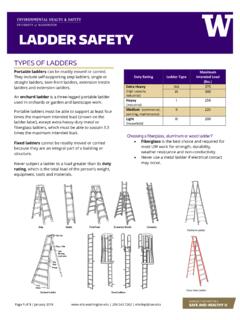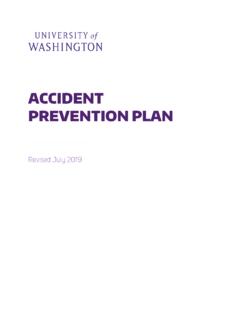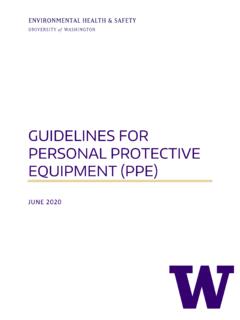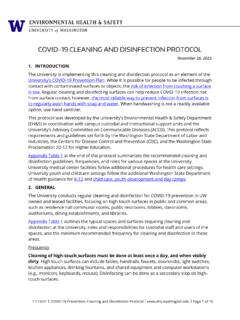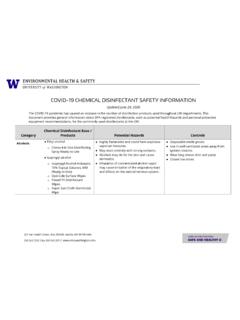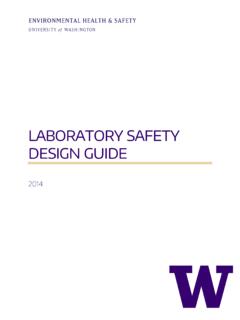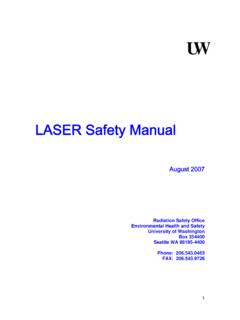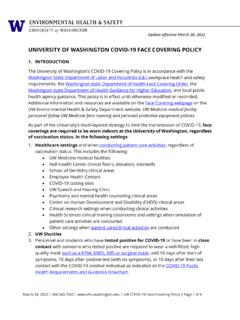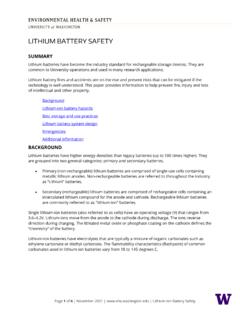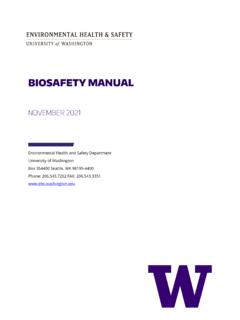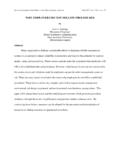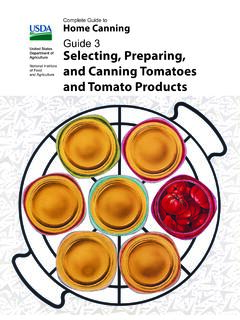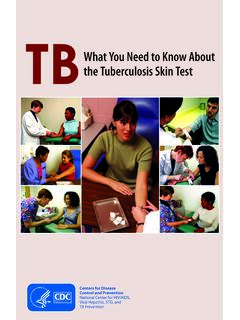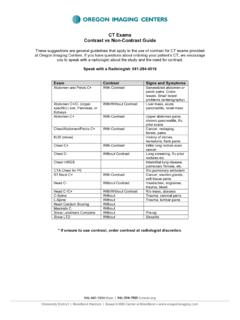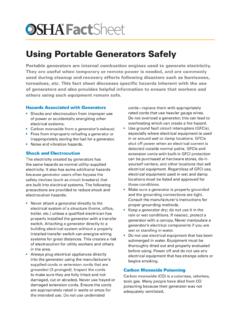Transcription of EATING AND DRINKING GUIDANCE FOR COVID-19 …
1 Page 1 of 4 | August 31, 2021 | | EATING and DRINKING GUIDANCE for COVID-19 Prevention EATING AND DRINKING GUIDANCE FOR COVID-19 PREVENTION INTRODUCTION This document provides best practices for minimizing the potential for COVID-19 transmission while EATING and DRINKING and meeting compliance with state and local requirements. The UW Face Covering Policy allows individuals to unmask when actively EATING and DRINKING in appropriate places. When face coverings are removed for EATING and DRINKING an individual will release more respiratory droplets and small particles (aerosols) while chewing, breathing, laughing, and speaking.
2 If a person is infected with COVID-19 , the respiratory droplets and aerosols they exhale can contain the SARS-CoV-2 virus which have the potential to expose others. COVID-19 SAFETY PRACTICES WHILE EATING AND DRINKING In addition to getting vaccinated against COVID-19 , and staying home when you are sick, utilize the following approaches to limit the potential for exposure to the SARS-CoV-2 virus while EATING and DRINKING . Choose to eat and drink where there is natural or mechanical ventilation, in order of preference: o outdoors when possible; o in a private room or office with the door closed.
3 O at a food establishment or unit or department designated EATING / DRINKING space, o alone at your desk in a shared workspace or study space when no one else is there; o as a last resort, with unmasked time minimized to a short duration, in an open building space where you can distance at least 6 feet from others. o Although, individuals should eat and drink in appropriate or designated spaces, hydration is important and intermittently consuming water or other beverages in a shared workspace, public/common area, or classroom is allowed if you can: Wash/sanitize your hands before and after touching your mask; Lift or remove your face covering for a brief moment while taking a drink, immediately put your mask back after DRINKING .
4 Do not eat or permit EATING during indoor classroom sessions or active meetings. Offer break times during longer meetings to allow attendees to eat/drink elsewhere Page 2 of 4 | August 31, 2021 | | EATING and DRINKING GUIDANCE for COVID-19 Prevention ( , in their private office, in a less crowded designated EATING space, or outdoors) as needed. Minimize the amount of time your face covering is removed for EATING / DRINKING and put it back on when you are not actively EATING / DRINKING . Minimize your time in the EATING space to make room for others. Limit socializing while unmasked. Practice good hand hygiene.
5 Wash or sanitize hands before and after EATING , touching your mask, touching your face, and touching high-touch surfaces. Where possible, choose seats and locations where you can distance from others while indoors. Consider EATING alone or in small groups. Maximize the effectiveness of your face covering. Wearing a multi-layer cloth or medical procedure mask (which provide better filtration efficiency) when you are sharing a space with others who are removing their face coverings to eat and drink. PREPARE EATING / DRINKING SPACES Units should consider the below GUIDANCE when designating University unit indoor EATING / DRINKING spaces ( , lunch and break rooms or meetings where food is served) and during events where food is served.
6 Food establishments, medical centers, and residence halls should follow their location or unit-specific procedures which meet local, state and University requirements specific to those spaces. Designate an EATING / DRINKING space: Identify a clearly defined area or room for EATING and DRINKING ; ideally with a closeable door and separate from workspaces or study spaces. o Select spaces with accessible operable windows or that are mechanically ventilated. Contact your building coordinator for help, if needed. o Arrange the furniture to stagger EATING locations within the designated space to support physical distancing as possible, and limit individuals sitting face-to-face in close proximity.
7 O Consider designating multiple spaces to prevent crowding and allow individuals to distance from each other. Face coverings: Wearing a face covering is required for all individuals while indoors at a University location, except when actively EATING or DRINKING in appropriate places ( , food establishments or designated EATING / DRINKING spaces). Read the UW COVID-19 Face Covering Policy for more information about the face covering requirement. Page 3 of 4 | August 31, 2021 | | EATING and DRINKING GUIDANCE for COVID-19 Prevention Ventilation: Refer to the COVID-19 Ventilation FAQs for information on mechanical and natural ventilation.
8 If needed, units may consider adding portable air cleaners to enhance ventilation in designated EATING spaces where physical distancing may not be possible. Contact your facilities manager/building coordinator to inquire about using a portable air cleaner for COVID-19 prevention in a designated EATING space. Physical Distancing o Individuals are recommended to physically distance from others where possible while indoors when actively EATING and DRINKING . o Physical distancing is required for all in health care, child care, youth and K-12 settings. EATING area seating must be arranged to support 6-foot distancing between individuals in these settings.
9 Signage: Post signage identifying this space as a designated EATING / DRINKING space and detailing expectations for use of the space. Signage should include face covering requirements, hand hygiene, user responsibility for cleaning/disinfecting high-touch and shared surfaces, and staying home if sick. Include signage that encourages users to limit time in space ( , 30-minute recommended duration) in consideration of others. Cleaning and disinfection o Provide cleaning supplies and disinfectant wipes for users to clean and disinfect high-touch and shared surfaces before and after use. o If the EATING area has a sink, ensure it is stocked with soap and paper towels; if there is no hand sink, provide hand sanitizer.
10 O Provide no-touch waste disposal bins. EATING / DRINKING SPACE USE Managers should consider staggering staff break times and other methods to minimize the number of people in break rooms or designated EATING spaces at any given time. Encourage users not to linger/socialize in designated EATING spaces. This allows more people to use the designated space and reduces the potential for crowding. Page 4 of 4 | August 31, 2021 | | EATING and DRINKING GUIDANCE for COVID-19 Prevention Make handwashing sinks and/or hand sanitizer easily accessible in the EATING space to support good hand hygiene.
